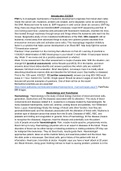Lecture notes
BS5111 Blood Component Production and Disorders
- Institution
- University Of East London (UEL)
This introduces blood and haematology. The production of the blood components, such as thrombopoiesis and erythropoiesis, is discussed in detail. The clinical applications of hematopoiesis is described.
[Show more]



